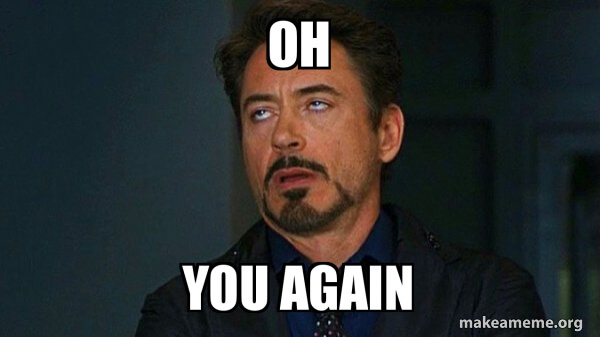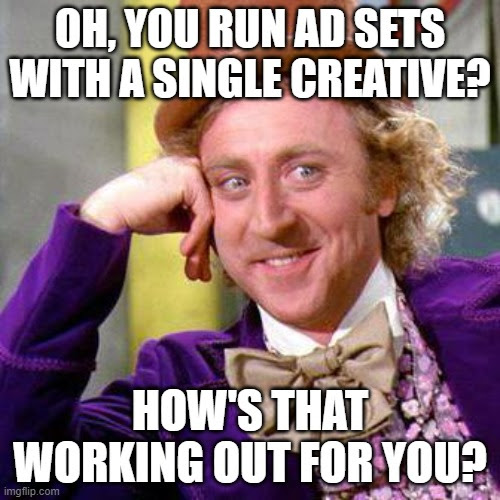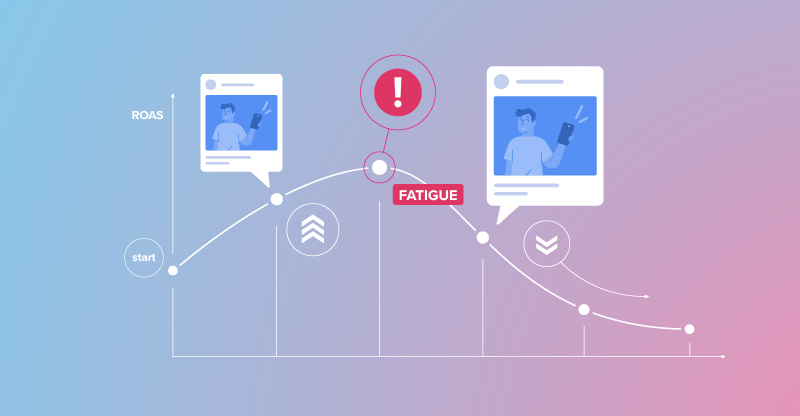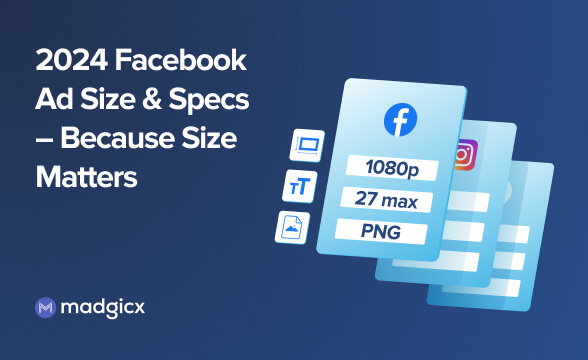Like humans, Facebook ad accounts might suffer illnesses. One you’ll be familiar with is Facebook ad fatigue. Here’s how to diagnose and treat it efficiently.
If a successful Facebook ad campaign suddenly shows a drop in performance, your first response needs to be a diagnosis. If the unhealthy campaign or ad set also demonstrates a high frequency, these are clear symptoms of Facebook ad fatigue.
Ad fatigue on Facebook should be treated quickly before it escalates to severe audience fatigue. This phenomenon might harm your ad account, but if you know how to identify the issue and treat it, there’s a good chance for recovery.
What is Facebook ad fatigue?
When an ad, ad set, or campaign experiences fatigue, it means its target audience has grown tired of seeing it. They click on the ad a lot less, which puts your ad’s CTR and conversion rates down, and your CPA up. In short, its effect on ROAS can put a whole ad campaign down.
Symptoms of ad fatigue show that something in your ads needs to change to keep the campaign on its heels. It may be the ads’ creative, copy, audience, or budget. When you’re looking for indicators of ad fatigue, one of the key metrics is frequency.
Frequency
Frequency is an estimated metric derived from ad impressions and reach. It shows you the average number of times a user in your audience saw your ad within a certain time frame.
High frequency helps you build awareness and recall by showing your ads to your target audience many times. The frequency for acquisition campaigns may average one to two, which means each user sees your ad about one to two times. Budget, audience size, and schedule may increase your ad frequency.
If you look at your retargeting, retention, and acquisition campaigns, you’ll notice that your retargeting and retention ones have higher frequency numbers. In acquisition campaigns, frequency is lower because of the broad audiences you’re targeting to introduce your brand.

To clarify, not every frequency increase should be diagnosed as ad fatigue. This is especially true for campaigns with a higher-than-normal frequency that are still producing good results. We all know how the saying “if it ain’t broke, don’t fix it” goes.
Although if you’re looking at an acquisition campaign with a frequency number too high for its nature, you might need to review your audience exclusions.
Pro Tip: Madgicx’s Audiences have pre-set exclusions, which ensure you’re not targeting past website visitors and customers who purchased from you in the last 180 days in your acquisition campaigns.
Facebook Inspect tool
Facebook Ads Manager has an Inspect tool that you should find when you hover over or select a particular ad set you want to review. This tool is available for active ad sets with any of the following campaign objectives: lead generation, app installs, conversions, and link clicks.

From there, you should see data collected throughout the ad set’s run. It’s an effective way to measure if your ad spend is generating your desired results and if your ad sets are showing symptoms of ad fatigue. If you want to view your ad set’s metrics for a specific date range, don’t forget to select your range at the top right once you’re in the “Inspect” view.
Note: You need to have at least three days’ worth of data to use the Inspect tool.

For example, your ad set’s Audience Saturation section tells you the percentage of your target audience reached by that ad set, lifetime frequency, lifetime reach, and how much of your lifetime reach consists of first-time impressions. Additionally, this chart tells you how the metrics mentioned affected your lifetime and daily cost per result. When combined, the data derived can give you insights into the ad set’s condition — is it fatiguing or not?

Identifying creative fatigue in Facebook Ads Manager
Aside from reviewing your frequency metric along with other relevant metrics (which we’ll tell you about in the next section), you can also see a Creative Fatigue status under the Delivery column in the ad set level. Facebook shows you this status when it believes your target audience is exhausted because of a run-down creative.

The Creative Fatigue status is an excellent indicator that it’s time to freshen things up to revive your tired audience.
Note: This feature is not available in the following cases:
- Ad sets with multiple ads
- Ad sets with Reach, Engagement, Brand Awareness or Video View campaign objectives
- Dynamic ads
- Dynamic creative
- Carousel ads
- Automated App ads
3 Signs of Facebook ad fatigue
When it comes to ad fatigue, your go-to metrics are the ones you check regularly. Aside from giving your performance insights, they can help you find signs of ad fatigue which you can cure later in the process.
1. Decreasing ROAS
If there’s an acronym that’s overused in advertising, it’s ROAS. This metric defines the success and failure of ad campaigns and the results of your marketing strategy.
A decrease in ROAS is the first indicator of a performance drop. Once you notice that, you should look for the reason for this drop, and ad fatigue is one of the immediate suspects. The first thing you should check is your frequency, and you can also inspect audience saturation using the Inspect Tool. This data should help you assess whether it’s a case of ad fatigue or not.
2. Increasing cost per result
Cost per result is a metric indicating how cost-efficient your ad campaign is at achieving the objectives you set. It’s used to compare performance among different campaigns and identify areas of opportunity and improvement.
Once you start paying more per result, it’s an indication of plummeting campaign performance and your ads are becoming less effective in moving audiences down the sales funnel. Moreover, a rise in your cost per result also affects your conversion rates.
3. CTR drop
CTR is a Facebook Ads metric measuring the ratio of clicks to impressions for each ad. Facebook calculates CTR by dividing the ad’s total number of clicks by its number of impressions. The quotient is multiplied by 100 and expressed as a percentage.
Users click on your ads when they’re interested in your ad and what you have to offer. When an ad is experiencing ad fatigue, a gradual fall in CTR is one of the first signs. As your audience grows tired of seeing the same ad, they click on it a lot less.
This applies to ads with high CTR at the early stages of their run. If your ad has a consistently low CTR, it could be something other than ad fatigue.
How to use Ads Manager 2.0 to recognize ad fatigue
Not every ad frequency hike indicates ad fatigue if they’re not underperforming. It’s important to consider both factors to avoid mistakes. To make analysis easier, you can tap into Madgicx’s Ads Manager 2.0. In its dashboard, you’re given a view of your assets, a review of the latest actions and performance trends, and you can filter important metrics to measure your ad’s performance.
Our example below shows a retargeting campaign that performed well initially but showed a big decline well into its run. The performance over time trend shows the ROAS in the last 5 weeks. This can help you identify a decline in performance even if the average ROAS for the selected timeframe seems OK. Pair this with the high frequency here, and you get a clear case of ad fatigue.

To get a more detailed view of your assets, you can click on the drop-down menu to the left of your asset’s name to see which ad set or ad is suffering from fatigue. In this case, the advertiser is using a single creative in this retargeting ad set, which leads the ad to fatiguing quicker.
Audience fatigue
As you run routine check-ups of your campaigns to monitor performance, you have to be mindful of audience fatigue. It’s an advanced case of ad fatigue that occurs when you saturate small audiences, which leads them to ignore your ads.

Facebook Ads Manager’s Inspect tool is a great way to find signs of audience fatigue. To be specific, you can use the trends from the Audience Saturation section. The First Time Impression Ratio and Audience Reached Ratio will tell you if you’re reaching new people and if you’ve already exhausted your target audience.
Our example shows that more than half of the impressions are fresh, which leads this ad set’s cost per result to be lower. This tells us that this ad set doesn’t need treatment for audience fatigue or ad fatigue.

Moreover, the Audience Reached Ratio is only nearing 2 percent, which shows us a good case that it’s nowhere near ad fatigue yet and people are still paying attention and acting on CTAs.

If you notice audience fatigue too late, chances are new creatives and lowering budgets won’t help your affected ads recover. Since audience fatigue is all about your audience, the best way around it is audience expansion. Add new people to your audience to get new eyes to see your ads!
6 ways to treat Facebook ad fatigue
Now that you know how to diagnose an ad with the symptoms of ad fatigue, it’s time to learn how to cure it. In Facebook advertising, it’s common for ads to undergo this phenomenon. When you’re beginning to spot slivers of ad fatigue, it’s time to apply ways to combat it. Here’s a list of ways to defeat Facebook ad fatigue to help your ads’ performance and ultimately increase your ROAS:
1. Change your creative
Even if your ad creatives are exceptionally good and come out with good results, people are bound to get tired of seeing them. Facebook ads saturation isn’t a myth -- ad fatigue happens to everyone who sees the same advertisements over and over.

That’s why changing up your creative is critical to getting rid of ad fatigue. We see many advertisers running just a single ad image or video per ad set, which often quickly leads to ad fatigue. That’s why it’s better to use 3-4 creatives in every ad set.
If your ad set is already showing signs of fatigue, add new images, replace the existing ones, and try out new ad formats that you haven’t tried yet, such as videos or Carousel ads.
You should also test new angles and messaging. If you want to connect with your potential customers on a personal level, you have to let them know that your brand is for them. Show your audience individuals with qualities they can relate to. For example, people who work in the same position as your target market or encounter the same issues they do.
Lastly, you can step up your brand trust and authenticity game by showing user-generated content to your potential customers.
Note: When coming up with a new creative, make sure to follow Facebook’s ad size and design specs based on your ad format and placements.
2. Refresh your copy
When it comes to ad fatigue, one of the forces behind the phenomenon is a stale ad copy that’s been on people’s news feeds too many times. The ad copy you currently have might’ve worked before, but people will eventually get tired of your text lines. Fortunately, you can always refresh your ad copy to pique people’s interest again. A good measure is to change the way you convey your brand’s message to your customers. Who likes reading the same text over and over, right?
Note: When you introduce significant changes to an existing ad, it re-enters the learning phase. In this phase, your ad gets unstable performance results as Facebook’s algorithm explores the best people and places to show your ad.
3. Expand your audience
Expanding your audience is the only way to revive a fatigued audience. When your audience gets bombarded with the same ad, they'll start ignoring, hiding, and reporting your ads. As an advertiser, the last thing you want is negative audience feedback.
To avoid oversaturating the same people with your ad, expanding your audience is an excellent measure. You can add new relevant locations for a bigger audience size, use custom audiences, utilize interest targeting, or target new lookalike audiences.
These options will help you deliver your ads to new but relevant viewers, lowering your frequency and costs and increasing ad campaign effectiveness.
4. Explore new placements
Exploring new placements when you’re seeing signs of Facebook ad fatigue is a way to lower your frequency. It also lets you show your newly curated ads to fresh sets of audiences who frequent other social media platforms.
Trying out new Facebook ad placements is a good option when you want to lessen the chances of your audience getting flooded with your ads. So, if you’re spending a lot on Facebook placements and suffering from ad fatigue, you can try manually placing your ads on other platforms such as Messenger, Instagram, or Audience Network to reach new audiences and prevent Facebook ads saturation.
5. Decrease your budget
When your ad is showing symptoms of fatigue, lowering its bid or budget is much like providing first aid. It’s a good way to prevent that fatigued ad from vacuuming money out of your budget, and you can give it more intensive care once you’re sure it’s not wasting ad spend.
After you’ve lowered the budget, that particular ad will earn fewer impressions, which may lower your frequency and relieve the fatigue it's under.
6. Set a custom frequency cap
When you run ads with the Reach objective, a good measure to avoid AND relieve ad fatigue is giving your campaigns a custom frequency cap. In getting campaigns with this optimization out of a rut (or preventing their fall into one), setting the optimal level of frequency is crucial.
If you don’t set a custom frequency cap, Facebook’s algorithm will automatically dictate your frequency to get you the lowest cost per result. However, if you have an assessment of your desired frequency based on your historical data, you can fine-tune the parameters in advance to mitigate the risk of ad fatigue.
Moreover, if one of your ad sets is suffering ad fatigue, you can set a frequency cap or change the existing one even while the campaign is running. Lowering your frequency is another great first-aid method, and it may also help you reach new people in your audience and revive this fatiguing ad set.
Pro Tip: If you’re running a Reach campaign targeting an acquisition audience and noticing ad fatigue, the reasons might be a mistake in exclusions. Make sure to exclude your website visitors and customers from acquisition campaigns to avoid this issue.
Ready to nurse your ads?
After diagnosing what’s crippling your campaigns, it’s time for treatment.
As you run your campaigns with a good understanding of what ad fatigue is and how you can treat it effectively, it’s also good to keep in mind that if you practice the ways to avoid fatigue before it even sets in, your campaigns will perform much better and have a better shot at conversions. And isn’t prevention better than a cure?
Prevent the sudden spikes in costs due to ad fatigue. Madgicx’s Creative Suite has all the tools you need to ensure you’re constantly producing fresh and high-converting ads.
Natalie values content writing as a way to inform and ask people questions. To her, posing questions spark her own and others' curiosity and encourage learning.









